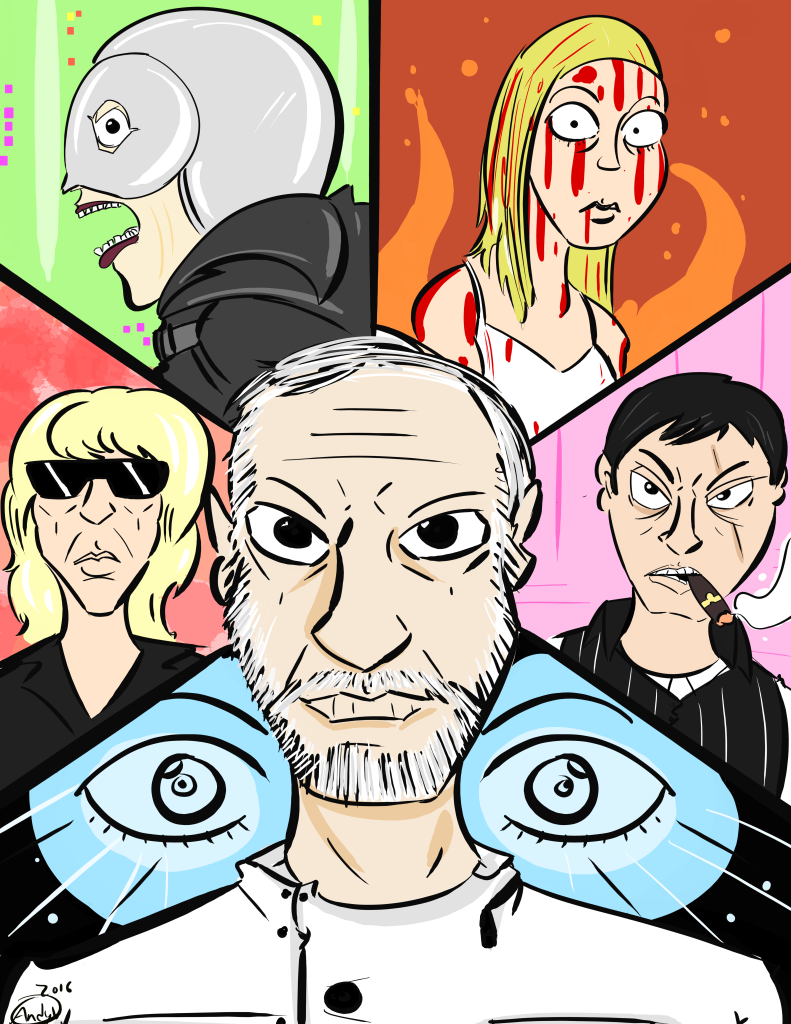
Original art by Andy Vanderbilt!
With the new documentary DE PALMA sparking retrospectives across the country and inspiring reconsiderations all over the critical realm, it felt like the right time to ask our contributors…
WHAT’S YOUR FAVORITE BRIAN DE PALMA MOVIE?
OR ELSE…
WHICH ONE DO YOU THINK DESERVES ANOTHER LOOK?
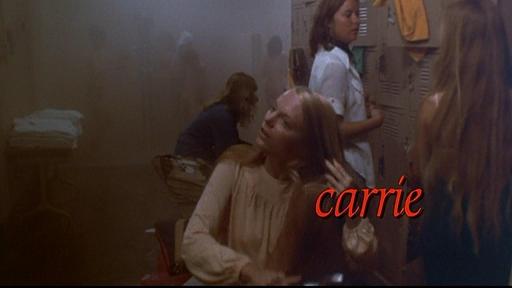
JEREMY LOWE: It had to have been October of ’89, and I had just started junior high. After school I’d always hang out at my best friend’s house and watch TV. Of course being Halloween season we were looking forward to seeing some brutal horror movie. Needless to say, his Mom was home early from work and watching some old chick flick. Ugh!
Regardless, we sat for a minute. Woah, why are all they throwing tampons at this poor girl? “I thought you liked horror movies and Stephen King?”, asked Jon’s mother. I answered, “of course I do, especially horror movies based on Stephen King books” (at 12 years old, I hadn’t actually read any Stephen King books). “Well, this is CARRIE, watch it, you’ll like it.”
Mrs. Dubey was wrong, I didn’t like CARRIE, I fucking loved it! Being a shy outcast, I genuinely felt for Carrie White (Sissy Spacek). I could completely identify with her. All she wanted was to fit in. The direction was so excellent. Each character knew who they were and what they were doing. During the whole film, I just wanted poor Carrie to get her revenge. When she did, it was spectacular! I loved the blood, the chaos, it was everything I wanted. The score really intensified the whole scene. Then to witness all this in a crazy split screen, what I later learned to be one of Brian De Palma’s trademarks, overwhelmed me… completely blew my mind.
Brian De Palma’s 1976 adaptation of CARRIE will always be one of the best horror movies, high school revenge film, and my kind of chick flick!
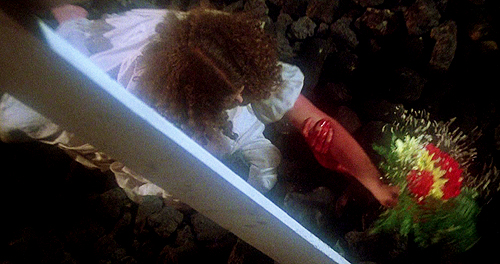
MIKE VANDERBILT: The hand out of the grave gets me every time, even though I know it’s coming.

BRETT GALLMAN: While it was released earlier in 1976, Brian De Palma’s OBSESSION soon found itself in the shadow of CARRIE, meaning it was destined to be forever overlooked in the director’s oeuvre. In retrospect, it’s almost apt that these particular films arrived within months of each other because they capture a director at a crossroads. Over the course of the previous five years, De Palma had come to find a singular voice in films like SISTERS and PHANTOM OF THE PARADISE, and CARRIE feels like a culmination: this was the moment De Palma truly arrived.
And yet, it wasn’t quite enough for Brian De Palma to just be Brian De Palma, as he found himself famously chasing the ghosts of Hitchcock. That chase was arguably never as furious (or obvious) as it is with OBSESSION, which finds De Palma and co-writer Paul Schrader circling VERTIGO (to the tune of a Bernard Herrmann score, no less). Cliff Robertson replaces Jimmy Stewart as the ill-fated, lovelorn man at the film’s center, a New Orleans real estate developer who loses his wife and daughter to a botched kidnapping scheme. Years later, he falls for and marries a woman who bears a striking resemblance to his dead wife, and déjà vu appropriately hangs thick as De Palma retraces Hitchcock’s steps.
The layers of familiarity are almost deceptive: it’d be easy to dismiss OBSESSION as De Palma’s fanboy attempt to ape his idol, especially since his devotion to recapturing Hitchcock’s sweeping, melodramatic aesthetic is almost slavish. However, it’s more a fitting decoy designed to lure an unsuspecting audience down a path that quickly veers into the sort of lurid territory that Hitchcock only implied. OBSESSION climaxes with a dizzying display of ambiguity, a sublime moment that rapturously lays bare the psychosexual preoccupations of its director. It can be argued that this, too, is the moment De Palma truly arrived — even if he only stepped out of Hitchcock’s shadow long enough to be caught in his own a few months later.

PATRICK SMITH: I tend to separate De Palma into two categories: Prime-De Palma and Sub-De Palma. His prime stuff is pretty easy to recognize, with THE PHANTOM OF THE PARADISE, SISTERS, CARRIE, BLOW OUT, and DRESSED TO KILL, and his sub stuff (while still great) is everything else. That all being said though there’s only one movie that’s PURE Brian De Palma, a film that puts all of his strengths and weaknesses on display in one gloriously grimy package.
Thats right, I’m talking about BODY DOUBLE.
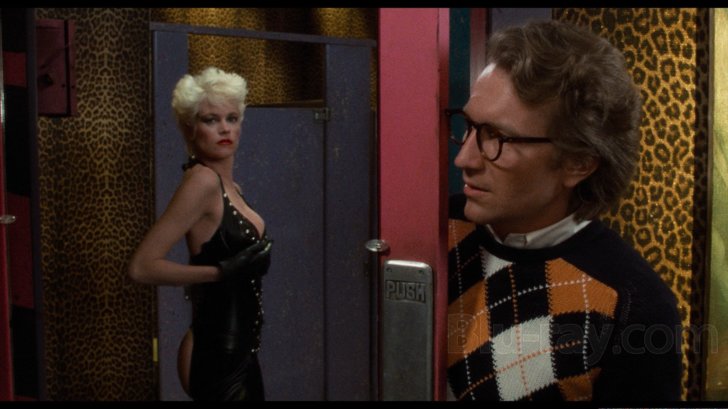
De Palma has always been the thinking man’s pervert, but it’s always been countered by craft and style, and although BODY DOUBLE is just as craftily stylish as any of his other movies, there’s no countering this flick’s hot-blooded heart of darkness. You’ve got your usual Hitchcock nods (specifically REAR WINDOW, with a pinch of VERTIGO) but De Palma puts more of himself in this than most. Craig Wasson’s every-man protagonist puts the audience into the role of watcher in such a way that De Palma effectively brings us all down into the gutter and makes us enjoy it as it happens.
Of course, when you’re watching an in-her-prime Melanie Griffith, I have a hard time feeling used. Supposedly De Palma wanted to originally cast porn actress Anette Haven in the role (complete with unsimulated sex scenes to boot), but the producers put a stop to that right quick, and De Palma went down a list of young actresses who all promptly passed. Thank god they did, because Griffith really goes for it. In the role of Holly Body, she brings a kind of mystique that all erotic performances have, in that it draws you in, while also making you feel a disconnect, which turns into a perfect foil for De Palma’s cinematic eye.
Add that on top of some of De Palma’s most cinematic moments he’s ever put to film, and the thing’s near jaw-dropping, whether it be the mall/beach foot chase, the “Relax” music video, or one of the most brutal on-the-nose slayings I’ve ever seen, where a woman is literally “drilled” to death. There is no shame, or half measures, or apologies in this film. Just De Palma putting everything he is and loves out there for the world to see, and although it made him a pariah for a while, I think the time has come for BODY DOUBLE to receive some real re-evaluation as the near-masterpiece it is.

MIKE VANDERBILT: Glad to see I’m in such good company listing BODY DOUBLE as possibly my favorite De Palma flick. Two other favorites of mine showcase different sides of the pervert of the New Hollywood clique: the sleazy, more personal, DRESSED TO KILL, and the ‘90s Hollywood bombast of SNAKE EYES.
DRESSED TO KILL is arguably the most autobiographical of DePalma’s works. Kicking off with all of DePalma’s favorite things: naked women, voyeurism, sex, and brutal violence, as Angie Dickinson’s Kate Miller possibly fantasizes about being raped and murdered in her home. Kate is a frustrated housewife looking for new sexual thrills, be it physical or mental, and soon she is brutally murdered From there, the Hitchockian murder mystery twists and turns around New York City, with Kate’s son Peter Miller (Keith Gordon) teaming up with prostitute-in-the-wrong-place-at-the-wrong-time, Liz Blake (Nancy Allen) to find the identity of the woman who murdered his mother.
DePalma deftly mixes subtlety, lulling the audience into false sense of safety — the playful museum scene — with over the top brutality — Dickinson’s murder in the elevator — throughout the film. Gordon’s Peter Miller acts as DePalma by proxy; a bright, inventive, young man with voyeuristic tendencies, much like De Palma built computers in high school, and spied on his father using recording equipment to find out if he was cheating on his mom. DRESSED TO KILL has trash, sleaze, and giallo in its D.N.A. (razor blades and leather gloves) but DePalma’s script is taut in all the right places, and in addition to the always slick camera work (and the soft, haziness of the whole thing reminds me of ’70s Penthouse Magazines) the director gets some great performances from Michael Caine, dorky Keith Gordon, the charming, plucky and sharp Nancy Allen, and a wonderfully greasy Dennis Franz.
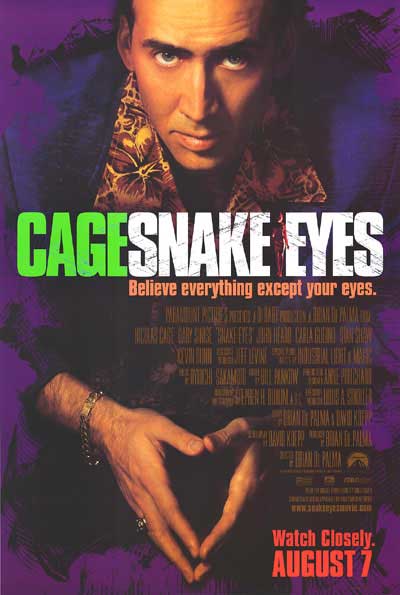
SNAKE EYES on the other hand, is more palatable to your typical audience, having more in common with MISSION: IMPOSSIBLE or THE UNTOUCHABLES at first glance. A collaborative effort from De Palma and screenwriter David Koepp, SNAKE EYES focuses on an assassination of a Senator by a cabal of patriots led by Gary Sinise’s Navy Cmdr. Kevin Dunne in an Atlantic City casino. SNAKE EYES deals with familiar De Palma themes such as loyalty, corruption, and conspiracy as Nicolas Cage’s sleazy corrupt cop attempts to solve the mystery in a sharp rust colored suit and Aloha shirt. Cage delivers a typical performance, all sleazy energy and loud mouth posturing with the occasional Nic Cage Freak Out (Patent Pending ). A cadre of genre favorites and character actors including John Heard, Stan Shaw, Kevin Dunn (the actor), Michael Rispoli, Mike Starr, and Luis Guzmán round out the cast. David Koepp’s script features political intrigue, but lacks the dangerous eroticism of DRESSED TO KILL and BODY DOUBLE, an element I happen to dig the most in De Palma movies. (That said, Carla Gugino is easy on the eyes as the film’s heroine.) The mystery at the core of the conspiracy is revealed early on in the film, but as DePalma explained upon the film’s release the movie is not about the core but rather about the relationship between Cage’s corrupt Rick Santoro, attempting to something pure, and good for once in his life, and Sinise’s murderous Boy Scout, who, while his intentions may be pure, is going about things the right way. We see two friends — told in broad strokes — who keep an uneasy loyalty to each other, even when at odds with what they believe is right. DePalma’s slick, knowing camera work (a very long take — with hidden edits — opens the film) elevates SNAKE EYES from forgettable Hollywood boilerplate to exciting, B-movie trash with a terrifically nihilistic ending.
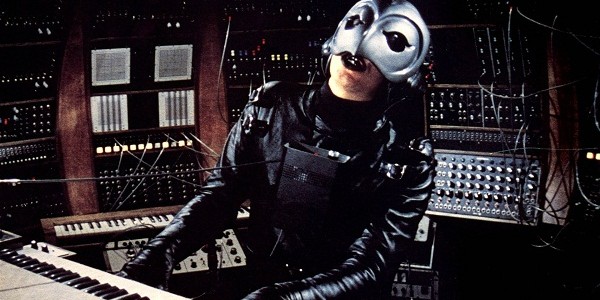
MIKE MCGRANAHAN: I’m a much bigger fan of DePalma’s earlier stuff (DRESSED TO KILL, BLOW OUT, etc.) than his later output. If I’m picking a favorite, though, I’d have to go with 1974’s PHANTOM OF THE PARADISE, for weirdly personal reasons. I was six when that film came out. One night, I was in the car with my parents, going who-knows-where, when we passed the local drive-in theater, which was playing PHANTOM. Already obsessed with movies even at that young age, I eagerly looked over to catch a glimpse of the screen as we drove by. In those five seconds, I saw the shot where the rock star known as Beef is electrocuted onstage and his face contorts from the shock. I’d never seen anything like that before. It was fascinating, making me wonder what the film was about and what other kinds of things happened in the story. It was only a few years ago that I finally got around to seeing PHANTOM OF THE PARADISE in its entirety, but to my delight, it was every bit as bizarre as I imagined it would be back in ’74. In many ways, this is the magic of movies for me. Little bits and pieces stick with you for years, or even decades, and the way you saw something becomes an integral part of your experience with it. I’m sure I would have enjoyed PHANTOM regardless (it’s got good music, great style, and an awesomely kooky sense of humor), but the fact that I had that tiny snippet lodged in my brain for years made my eventual discovery of the film so much more powerful.

MATT WEDGE: I used to feel the need to be a De Palma apologist. I cannot count how many times I would start defending films considered as “lesser” De Palma like RAISING CAIN, SNAKE EYES, or CASUALTIES OF WAR from charges ranging from ripping off Hitchcock to misogyny to repeating thematic and stylistic obsessions. But a few years ago, I noticed something that completely changed the way I watched movies (no matter who directed them) and considerably lowered my stress levels. I noticed that De Palma did not feel the need to apologize for his films. He did not make arguments factoring in historical context or citing a work as homage or simply using the auteur theory to justify his films that were critically maligned. If the director did not feel the need to justify his “lesser” films, why was I wasting my time and energy defending them against agenda-based reviews and Twitter trolls? All of which is to explain that when I say I flat out love a film like FEMME FATALE, I’m not trying to be contrary or pick a fight with De Palma’s detractors.
Truth be told, my favorite De Palma film is PHANTOM OF THE PARADISE. But for this question, I wanted to focus on one of his films that I felt had largely been forgotten or ignored, but is worthy of more attention. Based on that description, I could have gone with CARLITO’S WAY, THE FURY, HI, MOM!, or PASSION. But all those films have their vocal proponents and seem to have gathered more respect with age. But I find it odd that a film that is one of the most flamboyant embraces of De Palma’s style and obsessions as FEMME FATALE has largely fallen by the wayside.
When released, FEMME FATALE received the expected polarizing reviews from a handful of major critics. Roger Ebert afforded it four stars and said, “This is pure filmmaking, elegant and slippery. I haven’t had this much fun second-guessing a movie since MULHOLLAND DRIVE.” On the other hand, Owen Gleiberman gave it an “F” in Entertainment Weekly, saying, “…the story the movie tells is of Brian De Palma’s addiction to the junk-calorie suspense tropes that have all but ruined his career.” Obviously, there is quite a bit of hyperbole in both reviews and the movie does not back it all up, positive or negative. But overall, the reviews upon its release were mostly just shrug of the shoulders notices—polite in their praise and shallow in their criticisms. Aside from Ebert, very few critics noted that after a decade of big-budget bombs (MISSION TO MARS, SNAKE EYES, THE BONFIRE OF THE VANITIES), the occasional studio blockbuster (MISSION: IMPOSSIBLE), and two very different versions of De Palma’s playfulness with genre tropes (CARLITO’S WAY, RAISING CAIN), the director had returned to the mesmerizing, outlandish, sleazy, and hilarious territory of DRESSED TO KILL and BODY DOUBLE.
I think that is why I enjoy FEMME FATALE so much. No, it is not as consistently brilliant as anything De Palma made during his amazing eleven-year run from SISTERS to BODY DOUBLE, but it was such a treat to see him get back to what made him alternately a lauded auteur and a lightning rod for controversy. It was what I wanted from a De Palma film at that moment in time. It was bold. It was sexy. It was hilarious. It was pure, self-indulgent De Palma and he felt no need to apologize for it.

JOHN REENTS: I just watched it for at least the third time, and I still don’t quite know what to make of THE FURY, De Palma’s follow-up/companion piece to CARRIE. But I love it. With THE FURY, De Palma asks what would happen if someone with Carrie White’s power was born into a higher tax bracket. Carrie White’s more well-adjusted doppelganger, Gillian, is even played CARRIE‘s Amy Irving. Gillian is the daughter of a US Ambassador and goes to boarding school. And instead of CARRIE‘s traumatic shower scene, Gillian’s power is revealed during a classroom lesson on psychic phenomenon (that’s private school in the late 1970s for you). There’s also terrorists and a government plot by a secret government agency and Kirk Douglas and John Cassavetes and a true De Palma set piece involving an indoor ferris wheel and an angry telekinetic teenager.
Sometimes I genuinely wonder if De Palma made the movie to show other people how to rip off CARRIE. But at the same time, I just can’t dismiss THE FURY, not even as an ambitious mess. It’s possible that the reason I find it so fascinating is also why it’s remained under the radar since 1978: it’s almost unclassifiable. There’s teenagers, a secret government agency, and death via telekinesis. But it’s not a teen drama, a 70s paranoia thriller, or a horror movie. It’s all of those things, but really none of them.
I can’t even come up with a decent concluding sentence, so I’ll just mention that I saw THE BLACK DAHLIA in the theater. Twice.
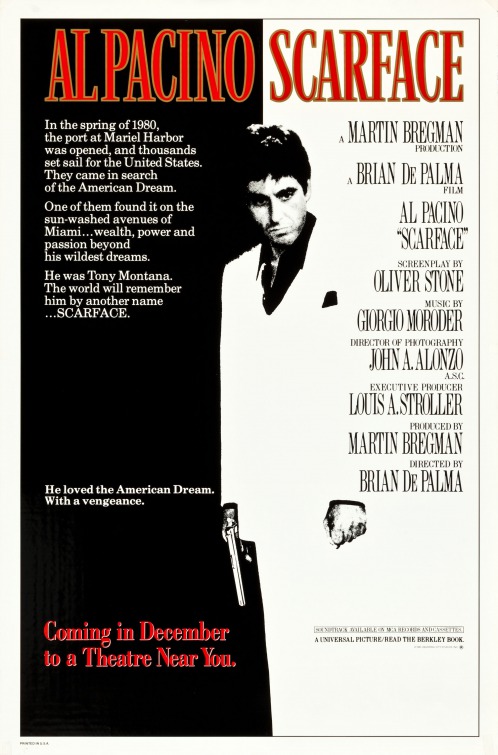
RYAN CAREY: Fuck it, I guess it might be an overly-obvious choice — although no one here has made it yet — but SCARFACE is an absolute classic. It’s not the sexualized updating on Hitchcock that DePalma made his bread and butter, but it’s a visceral, unforgettable gut-punch with incredible characters, razor-sharp dialogue, blistering and operatic ultraviolence, and pathos enough to make the ancient Greeks envious. One of the best crime films ever made.

JAMIE RIGHETTI: I can’t heap enough praise onto SISTERS (1973). Like many of my fellow contributors, I’m also a big fan of early De Palma films like THE FURY, DRESSED TO KILL, and BLOW OUT, but SISTERS is something extra special for me. I love seeing gritty old New York in all of its technicolor glory, especially Staten Island, which is often neglected (perhaps outside of HE KNOWS YOU’RE ALONE). The story centers on Danielle, a French-Canadian model, who is trying to escape her controlling husband and her unhinged sister, Dominique.
The film introduces a nod to REAR WINDOW (and De Palma’s split screen narrative) when Jennifer Salt’s social-justice-oriented journalist, Grace, witnesses Dominique murdering Danielle’s lover. Grace’s sanity comes into question when police cannot find a trace of the murder in Danielle’s apartment, a scene which shows De Palma’s masterful sense of tension. Grace’s quest for the truth leads her to a mental hospital, where she is to discover the truth about Dominique. Here, Grace is mistaken for a patient and her insistence on her true identity is laughed off as a delusion by the men in charge. It’s a truly harrowing moment that resonated with me as both a woman and a journalist, as Grace has her agency stripped from her so easily and quickly. This storyline was later revisited in American Horror Story: Asylum, a series on which Salt serves as both producer and writer. Finally, I adore the film’s dark ending, with everyone finally ready to believe Grace, who (thanks to her hypnosis at the hand’s of Danielle’s husband) no longer has any memory of the murder. De Palma would only get better after SISTERS, but the film’s flashes of genius, its unwavering commitment to exploring the darker side of identity, sanity and sexuality, paired with a unhappy and somewhat unresolved ending make it a must-see for me.
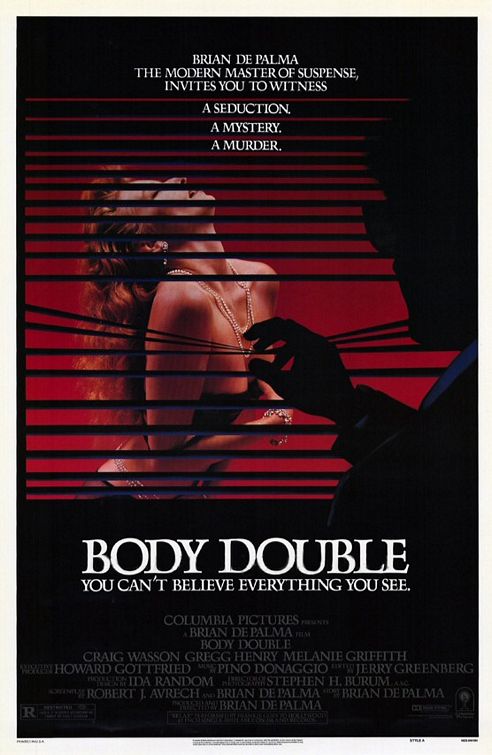
JON ZILLA: The one I’ve seen the most is SCARFACE. The one I’ve heard the most (due to the Ennio Morricone score) is THE UNTOUCHABLES. The one I’ve studied the closest is BLOW OUT. The one I’d most like to take another look at is THE BONFIRE OF THE VANITIES. The one I kinda still can’t believe actually exists is PHANTOM OF THE PARADISE. (And thank God for that one existing, by the way.) The first one I remember seeing is CASUALTIES OF WAR.
Then there’s the first one I didn’t remember seeing.

I watched BODY DOUBLE again in 2015. I thought I hadn’t seen it before, but I was mistaken. Ever have an involuntary autobiographical memory? Turns out I first saw BODY DOUBLE when I was six or seven. My dad was watching it on cable. I came in during the beach scene.
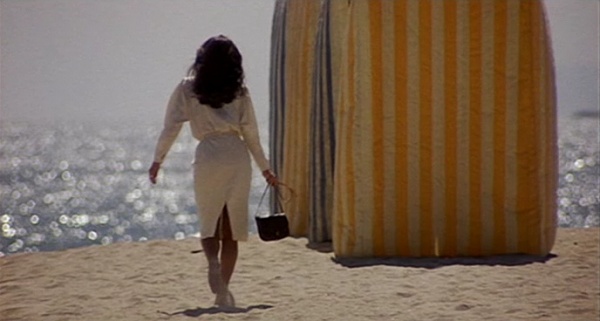
I remember now thinking it was a foreign film, since my dad watched plenty of those at the time, and particularly since that sequence is so sparsely worded, and heavy on soft-focus visual style and Pino Dinaggio’s orchestral music. (Not to mention that protagonist Craig Wasson has the sort of looks that would easier make sense for a star in France than one in America. There’s something sort of Depardieu-ish going on there.)

Anyway, if you remember how that scene ends, you might understand why I figured it was time I left the room. Unfortunately, all of that prompted a conversation about the birds and the bees that I was just not ready to have.
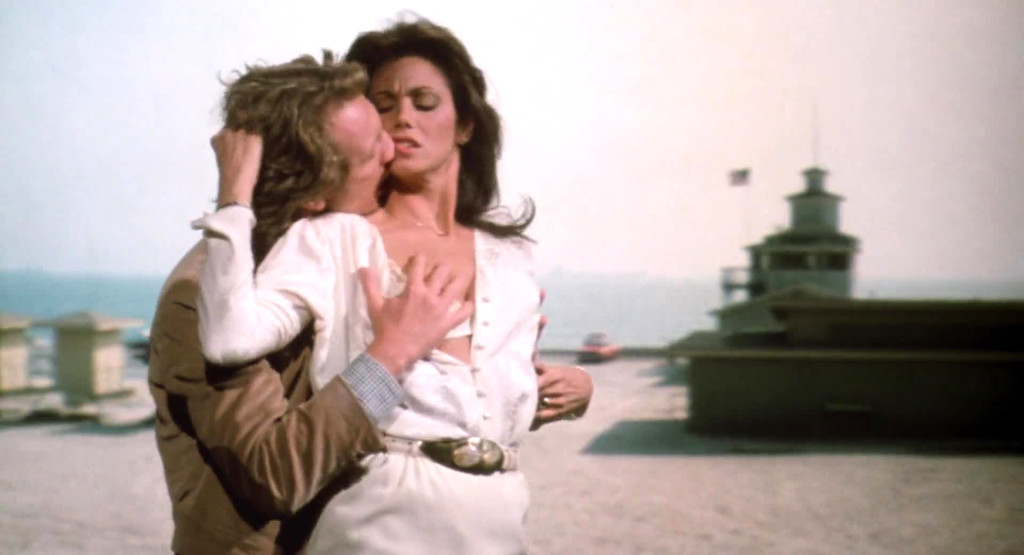
Some movies you can’t completely extricate from that sort of viewing experience. As an adult I can totally admire the film, even while re-experiencing it through the lens of a six-or-seven-year-old’s absolute confusion.

Now, I suppose, the rest is a matter for psychotherapy.


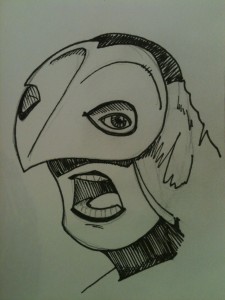 Original art by Jon Zilla!
Original art by Jon Zilla!
- [THE BIG QUESTION] WHAT’S YOUR FAVORITE FEMALE ENSEMBLE IN MOVIES? - July 22, 2016
- [IN THEATERS NOW] THE BOY (2016) - January 24, 2016
- Cult Movie Mania Releases Lucio Fulci Limited Edition VHS Sets - January 5, 2016
Tags: Al Pacino, Alfred Hitchcock, Angie Dickinson, Answers, Bernard Herrmann, brian de palma, Carla Gugino, Charles Durning, Cliff Robertson, Deborah Shelton, Dennis Franz, F. Murray Abraham, Gerrit Graham, Jennifer Salt, Jessica Harper, John Heard, John Lithgow, john travolta, Keith Gordon, Kevin Dunn, Luis Guzmán, Margot Kidder, Melanie Griffith, Michael Caine, Michael Rispoli, Michelle Pfeiffer, Mike Starr, nancy allen, Nicolas Cage, paul schrader, Paul Williams, Pino Dinaggio, Questions, Robert Loggia, Sean Penn, Sissy Spacek, Stan Shaw, Stephen King, William Finley






No Comments